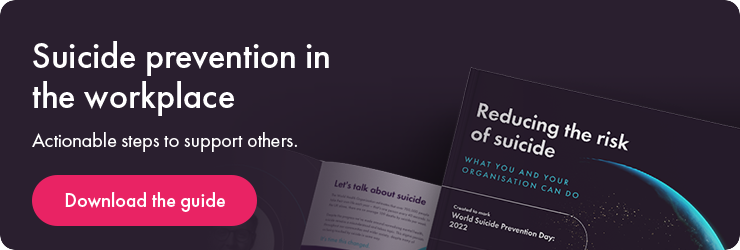According to research by PTSDUK, 1 in 2 people in the UK will have experienced a traumatic experience in their life. Of those, 20% will go on to develop post-traumatic stress disorder (PTSD).
That means 1 in 10 of us will experience PTSD, so there’s a high chance that someone in your organisation is either experiencing it, or has experienced it in the past.
As leaders or people managers, it’s vital that you understand what PTSD is, and learn how to support these employees or colleagues.
In this article, you’ll learn:
- PTS or PTSD
- What is PTSD?
- What causes PTSD?
- What are the symptoms of PTSD?
- The impact of PTSD in the workplace
- How to support employees experiencing PTSD in the workplace
PTS or PTSD?
Before we go on to examine PTSD in further detail, it’s worth noting that trauma is a complicated and subjective term. PTSD is often easier to spot and work with due to the number of symptoms that are present.
However, the D in PTSD stands for disorder, and to be truthful it is often better for your employees if you can think of it as PTS rather than including the end letter (that’s usually reserved for clinicians in diagnoses).
When we think of PTSD, we are often talking about PTS.
What is PTSD?
PTSD refers to a set of responses that usually develop after a person witnesses or experiences something traumatic.
Intrusive images and memories called flashbacks are perhaps the most well-known of these responses, but they also include changes in sleep patterns, fluctuating energy levels, sensitivity to others and cognitive issues like brain fog.
Traumatic events can make an individual feel out of control, unsafe and distrusting of or disconnected from others. These events also force people to question their assumptions about the world.
Essentially, PTSD is a set of reactions to a situation a person finds threatening.
What causes PTSD?
Most of what we hear in the media about PTSD is in relation to soldiers at war, but in fact, any kind of trauma can lead to PTSD developing, from serious car accidents to workplace traumas like abuse or assault.
PTSD can develop immediately after the trauma, or it can occur weeks later. It’s important to remember, however, that experiencing trauma doesn’t automatically mean a person will develop PTSD.
What are the symptoms of PTSD?
PTSD can manifest itself in different ways in different people, but there are some common symptoms that you, as a leader or people manager, can look out for.
The most common symptom of PTSD is reliving aspects of what happened, usually through realistic flashbacks, nightmares or intrusive thoughts.
These are often accompanied by intense feelings of alertness, anxiety or panic. Heightened emotions and disturbed sleep are common symptoms, and an individual experiencing PTSD may also find it difficult to concentrate on things such as work tasks.
They might lose trust in others or have difficulty believing they’ll ever feel “safe” again. Their heightened emotions can also result in increased irritability or aggressive outbursts – which co-workers may find difficult to deal with.
It is also common for those with PTSD to try and avoid being reminded of their traumatic event, either by avoiding certain people or places, or by avoiding talking about their experience.
They may try to numb their feelings or avoid confronting the trauma, by keeping busy or using substances like alcohol or drugs.
It can also be common for PTSD to present alongside other mental health problems, such as depression and anxiety. PTSD also represents a risk factor for suicidal thoughts and behaviours.
The impact of PTSD in the workplace
The symptoms of PTSD are often severe and persistent enough to have a significant impact on the day-to-day lives of employees.
One of the more noticeable effects is the impact it can have on relationships. Due to the heightened emotions and loss of trust that often accompany PTSD, it can be exhausting to be around someone who is experiencing it – particularly if you don’t understand what’s going on.
This can lead to relationships becoming strained and the individual feeling increasingly isolated or misunderstood.
Another work-related effect of PTSD is the impact it can have on performance and engagement. Individuals experiencing PTSD frequently find it difficult to engage with their work – and can find previously manageable tasks overwhelming.
This may be caused by various PTSD symptoms, including memory problems, difficulty concentrating, tiredness due to poor sleep and difficult relationships with co-workers.
These symptoms are often all-encompassing and can affect anything from being able to sit at a desk, to being able to get on the bus to work.
PTSD becomes even more problematic for employees who have experienced or witnessed a traumatic event at their place of work.
Because one of the primary symptoms of PTSD is avoidance of places and situations associated with the traumatic event, these employees may have an extremely difficult time returning to work.
How to support employees experiencing PTSD in the workplace
The experiences caused by PTSD can be incredibly debilitating for employees, so it’s vital that they are able to access support when they need it.
As with any mental health issue, it’s crucial to remember that PTSD affects different people in different ways, so a support system that works for one person may not work for everybody.
You should work with the individual employee to find and coordinate the best support system for them. Once that is done, you will need to regularly check in with and provide ongoing support to that individual.
To help with this, here are five ways that you can support an employee who is experiencing PTSD.
1. Educate yourself and your team
PTSD can be extremely difficult to understand, so make sure you are well-informed about what it is, and how it may affect employees.
By improving your understanding of PTSD, you will enable yourself to be more responsive to your employee’s needs.
It is also important to educate the rest of your team about PTSD, and how they can support a colleague who is experiencing it. This short video will help you understand how trauma and stress affect the body and relationships.
We would also encourage you to continue learning through other reputable sources like NHS, Mind and PTSDUK.
2. Build trust with the employee
As highlighted above, it is common for individuals with PTSD to lose trust in those around them, so taking steps to build or maintain that trust is incredibly important.
Offering reassurance when your employee needs it, demonstrating empathy when communicating with them, and making supportive adjustments to their working environment will all help to increase the employee’s sense of security and safety.
3. Make workplace adjustments
If an employee’s work performance is being affected by their PTSD symptoms, then take steps to try and prevent this.
Even simple adjustments may help an employee feel more able to work, despite their PTSD. Examples of these adjustments could be:
- Allowing the employee to sit where they feel most comfortable
- Designating a quiet spot where the employee can work away from a noisy office
- Putting measures in place to help the employee manage any panic attacks at work
As well as helping them to work well, these measures will also help to keep the employee in work, which may even aid their recovery.
To find the right adjustments to make, ask your employee what would be helpful, and use their answers to create their workplace plan.
If you’re struggling for ideas, read our resource on workplace adjustments for mental health.
4. Promote open conversation around mental health
Often, those experiencing PTSD may find it difficult to open up about it, or even admit that they’re struggling.
That’s why it’s so important to make sure that your office is a safe and secure place, where people feel comfortable discussing their mental health, without fear of ramifications or judgement.
By creating this environment, you will increase the chances of struggling employees opening up about their mental health, which will put you in a much better position to help them.
Read our guide on promoting mental health in the workplace for actionable ways that you can get the mental health conversation going.
5. Encourage the employee to seek help
If you believe an employee is experiencing PTSD, or even if they just look to be struggling, encourage them to seek help.
Not everyone experiencing PTSD will need professional help to recover. However, it is a good idea for everyone experiencing PTSD to speak to their GP, who can provide guidance on the best way forward.
As well as their GP, you could also signpost the employee to internal services, such as an Employee Assistance Program (EAP) or occupational health, or external services, such as PTSD At Work, or PTSDUK.
As referenced above, PTSD is also a risk factor for suicide.
Important: Concerned that a colleague or employee may be experiencing suicidal thoughts? Read our guide on supporting an employee in crisis and if you think someone is in immediate danger, follow these steps outlined by Samaritans.
You can make a difference
As a leader, you are in a position to make a huge difference to the life of an employee who is experiencing PTSD, either in a positive or a negative way.
If managed poorly, then these colleagues may really struggle to work to their full potential. However, if managed correctly, there is no reason why they cannot continue to be a valuable member of your team.
You don’t have to be a doctor or a psychologist to be able to help employees who are experiencing PTSD. Just showing you care, understanding how they may be feeling and knowing where to signpost them can be a huge help.






